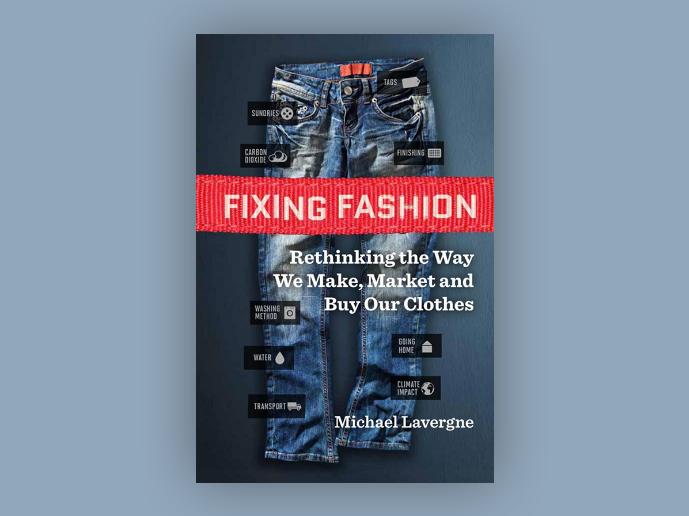Book Review: Fixing Fashion: Rethinking the Way We Make, Market and Buy Our Clothes
Michael Lavergne, Fixing Fashion: Rethinking the Way We Make, Market and Buy Our Clothes, New Society Publishers, $18.95, 256 pp., October 2015.
Former supply-chain-expert-turned-corporate-auditor Michael Lavergne does not mince words: capitalism is founded on exploitation, he argues in the opening chapter of his recent book, Fixing Fashion. A decade working in the apparel division of global companies such as Wal-Mart and Sara Lee (which, until 2005, owned Hanes) compelled Lavergne to not only depart but then take to task the very producers, distributors and retailers he once called his colleagues and friends. Given this switchover, Lavergne’s book is a surprisingly even-handed look at what Lavergne calls the “fallouts” of the fashion system and how they have been redressed. Auditing is an industry, too, he points out. Let’s look at all of the players – companies, governments, and activists alike – with a considered eye as we attempt to build different business models as well as social values.
Like many books on fashion and sustainability, Lavergne first offers a brief history of the textile and apparel industry to contextualize today’s business practices. From there, Lavergne’s book is singular in its first hand accounting of today’s fashion trade and the massive, multi-billion-dollar auditing sub-industry that emerged in the wake of media exposés on offshore sweatshop labor use in the early 1990s. In the U.S., the Kathie Lee Gifford case famously goaded Congress to action. When the actress and television host’s highly successful apparel label was found to sub-contract production to Central American sweatshops using child labor in 1996, Congress initiated a series of multi-stakeholder initiatives that became known as the Fair Labor Association (FLA). Gridlock over labor standards at the FLA, however, led many of the largest American apparel firms to seek a private industry solution in the form of the Worldwide Responsible Apparel Production (WRAP) program. The auditing business arose to ensure that the standards set by these and many smaller apparel and consumer good accountability programs would be met. That was the intention, at least. The reality, as Lavergne details, has been nothing short of a colossal disappointment.
Arguing that auditing procedures are in fact hypocrisy of the highest order, Lavergne steers us to other, more holistic approaches to tackling supply chain transparency. This is where the book loses traction for me. Reading case study after case study of programs such as the Netherlands-based Better Cotton Initiative (BCI), which focuses on training cotton producers to meet ethical production and labor standards, always seems promising until you reach the most critical segment of the supply chain: the corporate buyer who refuses to bite. Excitement over the availability of tons of Better Cotton or reams of data on forced labor in Uzbekistan quickly dissipates in the face of subsequent inaction on the part of the corporate agents bringing the final product to market. So what’s the point, Lavergne? He seems to recognize the impossibility of the task at hand when he acknowledges that “to some extent I do agree with those who say it is only the organizational power and expertise of global businesses that can move the market to change” [1].
Yes, short of an international governing body with robust enforcement mechanisms, a sustainable fashion system requires corporate involvement – specifically, sustained and comprehensive corporate involvement, which Lavergne fails to emphasize. WRAP established ethical standards but had little incentive to follow through. The big brands that supported the BCI at first, such as Adidas and The Gap, then failed to buy. Lavergne lauds H&M’s recent efforts to become “the sustainable fast-fashion leader,” but that doesn’t sound as impressive once you realize that H&M has exactly zero competition in that category. Even Patagonia, the largest brand in the industry founded on sustainability principles, doesn’t stand well to scrutiny. As the Wall Street Journal observes of the $800 million apparel “empire,” mass-market operations aren’t conducive to strict ethics.
The International Labor Organization’s 2016 report on global supply chain ethics discusses four types of governance relevant for improving production and labor conditions: public governance, private governance, social partners’ initiatives, and multi-lateral initiatives. And while, lucky for us, Lavergne’s expertise covers the latter three types, I really wanted him to be more critical – constructively critical – about private governance. Lavergne has claimed elsewhere that Patagonia founder Yves Chouinard is his hero; in the book’s last chapter, Lavergne also discusses global brands such as Adidas and Eileen Fisher whose sustainability strategies he endorses. I would love to see him devote his next book to assessing big brand private governance. If companies like Patagonia have tripled its profits in less than a decade without engaging in the kind of exploitation that Lavergne recognizes to be the industry norm, I still need to be convinced.
Notes
[1] Michael Lavergne, Fixing Fashion: Rethinking the Way We Make, Market and Buy Our Clothes (Gabriola Island: New Society Publishers, 2016), 142.



